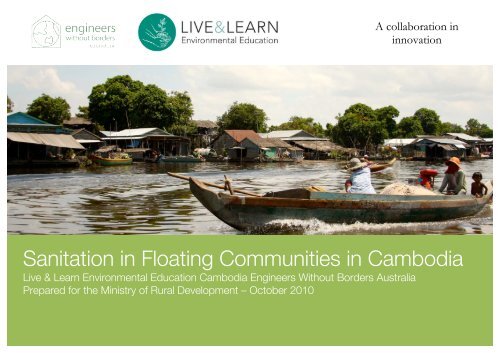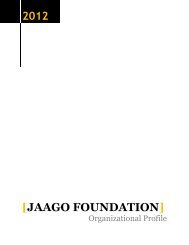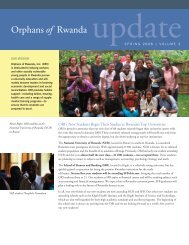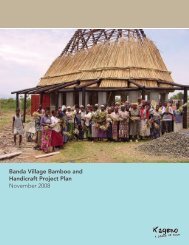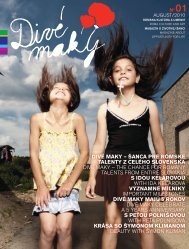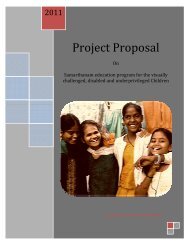Sanitation in Floating Communities in Cambodia - Sustainable ...
Sanitation in Floating Communities in Cambodia - Sustainable ...
Sanitation in Floating Communities in Cambodia - Sustainable ...
- No tags were found...
You also want an ePaper? Increase the reach of your titles
YUMPU automatically turns print PDFs into web optimized ePapers that Google loves.
A collaboration <strong>in</strong><strong>in</strong>novation<strong>Sanitation</strong> <strong>in</strong> Float<strong>in</strong>g <strong>Communities</strong> <strong>in</strong> <strong>Cambodia</strong>Live & Learn Environmental Education <strong>Cambodia</strong> Eng<strong>in</strong>eers Without Borders AustraliaPrepared for the M<strong>in</strong>istry of Rural Development – October 2010
Lead Author:Michael BrownContribut<strong>in</strong>g Authors:HONG Sodaneath, Jady Smith, Judy Hagan, KEATBunthan© 2010This work is licensed under the CreativeCommons Attribution-Non-commercial-ShareAlike 3.0 Unported License. To viewa copy of this license, visit http:/creativecommons.org/licenses/by-ncsa/3.0/or send a letter to CreativeCommons, 171 Second Street, Suite 300,San Francisco, California, 94105, USA.Photographs Copyright:Max Shapria, Michael Brown, HONG Sodaneath, JudyHaganGraphic Design:Jane HengSupported by:For more <strong>in</strong>formation about this project:float<strong>in</strong>gtoilet@gmail.comfacebook.com/float<strong>in</strong>glatr<strong>in</strong>elivelearn.orgewb.org.auii
ContentsIntroduction .................................................................................................... 1 A Personal Story ............................................................................................. 3 Project Implementation and Management ................................................. 4 Community Involvement .............................................................................. 5 Selection of the Target Community ........................................................ 6 Field Surveys ............................................................................................... 6 Development of Waste Management Station Concept ...................... 21 Construction of Float<strong>in</strong>g Community Waste Management Station . 23 Trial of Waste Management Station <strong>in</strong> Phat Sanday ........................... 24 Float<strong>in</strong>g Garden ............................................................................................ 25 <strong>Sanitation</strong> Upscale ........................................................................................ 26 Appendix 1 – Water Quality Test<strong>in</strong>g Results ........................................... 28 Community Focus Groups ....................................................................... 7 Results from Community Focus Groups ............................................... 8 Consultation with Community Groups ................................................ 11 Water Quality Test<strong>in</strong>g .................................................................................. 13 Float<strong>in</strong>g Toilet .............................................................................................. 14 Development of Float<strong>in</strong>g Latr<strong>in</strong>e Concept .......................................... 14 Float<strong>in</strong>g Toilet Design Philosophy ........................................................ 14 Float<strong>in</strong>g Toilet Design Specifications ................................................... 15 Trial of Float<strong>in</strong>g Latr<strong>in</strong>e <strong>in</strong> Phat Sanday ................................................... 18 Float<strong>in</strong>g Community Waste Management Cycle ..................................... 20 Waste Management Station ........................................................................ 21 iii
Quotes from the communityMr Sok Sueng:"Good <strong>Sanitation</strong> means goodhealth and livelihood"Ms Lai-Im:Community Liaison Officer"Clean water is the mostimportant th<strong>in</strong>g to ourcommunity"Mr Sok Sovann:"My float<strong>in</strong>g toilet is good formy health, is more convenientand private"Mr Pich Vongsa:Pr<strong>in</strong>ciple of the Phat Sanday Secondary School"Our community wastesmoney on health care, thatwe wouldn't need to spend ifthe water was clean"Mrs Yan Yeoun:"Clean water is important forour health"Mr Hakley Ke:Teacher at the Secondary SchoolCommunity Liaison Officer"I want everyone <strong>in</strong> thecommunity to have a toilet.”v
A Personal StoryMr LY HakleySchool Teacher from Phat Sanday Secondary SchoolThe practice of defecat<strong>in</strong>g directly <strong>in</strong>to the lake is convenient but degradesthe quality of water the community shares. Few public build<strong>in</strong>gs have toiletsfacilities. School children have tra<strong>in</strong>ed themselves to hold on dur<strong>in</strong>g theschool day only to relieve themselves <strong>in</strong> the even<strong>in</strong>g. This causes a particularproblem for girls once they reach menstruation. Studies have show that lackto private sanitation is one the key causes of school drop out girls.Hakley knows the lack of sanitation <strong>in</strong> float<strong>in</strong>g villages is a problem and isvery passionate out improv<strong>in</strong>g this situation for his community. He is ateacher at Phat Sanday Secondary School and has been very helpful and<strong>in</strong>spir<strong>in</strong>g to the team from Live & Learn who are work<strong>in</strong>g to developsanitation options for the float<strong>in</strong>g communities. He has allowed Live & Learnto trial one of their float<strong>in</strong>g toilets at the school and has been teach<strong>in</strong>g thestudents about how to use the toilet and why sanitation is important <strong>in</strong> theircommunity.With Hakley’s encouragement, the sanitation message has been filter<strong>in</strong>gthrough the village’s students and their families. For this reason L&L andEWB have been able to successful trial float<strong>in</strong>g toilets and change thesanitation behaviour of 14 households. Hakley has also been verysupportive of the project’s efforts to build a Float<strong>in</strong>g Community WasteManagement Station that will demonstrate safe treatment and reuse of thehuman waste. Once this is complete Hakley, the Phat Sanday Communityand L&L can work together to cont<strong>in</strong>ue build supply and demand forfloat<strong>in</strong>g toilets <strong>in</strong> Phat Sanday and other float<strong>in</strong>g communities on the TonleSap.Figure 3 - Mr LY Hakley <strong>in</strong> August 20103
Project Implementation and ManagementThe project is a collaboration between three key project partners, the PhatSanday Community, Live & Learn Environmental Education <strong>Cambodia</strong>(L&L) and Eng<strong>in</strong>eers Without Borders Australia (EWB). Key achievementsof this relationships has been:• Two members of the Phat Sanday Community have been assigned askey liaison officers to facilitate communication between Live & Learnand the community. This has help build our relationship with thecommunity and speed issues resolution. We have assigned one maleand one female liaison officer.• Established a new team of Eng<strong>in</strong>eers Without Borders Volunteers,called the EWB Innovators. This builds upon the success of EWB’sChallenge program that challenges 5000+ eng<strong>in</strong>eer<strong>in</strong>g students eachyear to develop appropriate technology for develop<strong>in</strong>g communities.The project implementation and management is structured as below:Project StakeholderLive & Learn EnvironmentalEducation <strong>Cambodia</strong> (L&L)Eng<strong>in</strong>eers Without BordersAustralia (EWB)M<strong>in</strong>istry of RuralDevelopment (MRD)Phat Sanday CommunityRoleProject Coord<strong>in</strong>ator, RelationshipBuild<strong>in</strong>g, Community EngagementTechnical and design support.Provide <strong>in</strong> country Project Manager.Access to WATSAN forum andl<strong>in</strong>kages to other organisationswork<strong>in</strong>g <strong>in</strong> <strong>Cambodia</strong>. Grantprovider.Community Engagement, Supportand Wil<strong>in</strong>ess, Input <strong>in</strong>to local designand materialsScience and TechnologyInnovations for the Base ofthe Pyramid <strong>in</strong> Southeast Asia(iBoP Asia)Resource DevelopmentInstitute <strong>Cambodia</strong> (RDI)Royal University Phnom Penh(RUPP)Project Grantee, Supervision,Monitor<strong>in</strong>g and Evaluation.Development of relationships withother iBOP Grantees <strong>in</strong> South EastAsia.Prototyp<strong>in</strong>g and design developmentexpertise <strong>in</strong> the <strong>Cambodia</strong>nenvironment. Lab test<strong>in</strong>g.Lab test<strong>in</strong>g, Relationship Build<strong>in</strong>gand Capacity DevelopmentFigure 4 - The project team <strong>in</strong> August 2010. Michael Brown (EWB), HONGSodaneath (L&L), LAY Im and LY Hakley (Phat Sanday)4
Community InvolvementThe unique Tonle Sap environment has driven a strong need for local<strong>in</strong>formation and feedback throughout the <strong>in</strong>novation process. This has beenobta<strong>in</strong>ed through a two way consultation process between all partners. Localknowledge has been and rema<strong>in</strong>s a critical factor govern<strong>in</strong>g the successfulimplementation of not only an appropriate system design, but alsoaccompany<strong>in</strong>g sanitation education for the local community.We have <strong>in</strong>volved the community at he follow<strong>in</strong>g stages:• Concept and Plann<strong>in</strong>g: We have conducted five focus groups andworkshops with different members of the community. We conductedseparate Men’s and Women’s focus groups. Workshops villagesleaders, school teachers and environmental rangers.• Design: The community has been consulted throughout the designprocess and their feedback feed back <strong>in</strong>to the design developed bythe eng<strong>in</strong>eers from Eng<strong>in</strong>eers Without Borders Australia.• Execution: We employed the services of two members of thecommunity on a part-time basis to help with execution of the project.Their assistance has enabled improved community feedback on theproject and allowed to access local skills and labour dur<strong>in</strong>gconstruction phase of the project.Methodologies we have undertaken to <strong>in</strong>volve the community have been:• Employ<strong>in</strong>g local staff members to build relationship with community• Engag<strong>in</strong>g local community members through out the plann<strong>in</strong>g,design and execution stage of the project.• Employ<strong>in</strong>g two members of the target community to help facilitatethe project.• Regular field trips to the community by all project members to buildrelationships and understand context of the communities.• Us<strong>in</strong>g local communities skills and experience <strong>in</strong> their environment tocomplement development and project management skills of Live &Learn.We have learnt from the community:• Innovative and cost effective construction methods for build<strong>in</strong>gfloat<strong>in</strong>g barges.• Details about appropriate local materials• Local customs and practices• Feedback from our designs.This level of community <strong>in</strong>volvement has made it much easier and quicker todevelop a solution that is susta<strong>in</strong>able, affordable and cultural affordable. Ithas enabled our design team <strong>in</strong> Australia to understand the context andchallenges of work<strong>in</strong>g <strong>in</strong> the float<strong>in</strong>g communities.Without this level of community <strong>in</strong>volvement the project would be verydifficult to complete and without it the project almost certa<strong>in</strong>ly be a failure asthe solution most likely would have been <strong>in</strong>appropriate for the communities’needs.Figure 5 - Community Workshop <strong>in</strong> July 20105
Selection of the Target CommunityAn assessment of village location was undertaken to determ<strong>in</strong>e anappropriate village for community engagement, education, establish<strong>in</strong>gwork<strong>in</strong>g groups, ga<strong>in</strong><strong>in</strong>g feedback on design approach, and trial of thefloat<strong>in</strong>g toilet prototype.Follow<strong>in</strong>g the assessment of many villages of the Tonle Sap, <strong>in</strong>clud<strong>in</strong>g sitevisits to eight villages, Phat Sanday Commune, Kampong Thom Prov<strong>in</strong>cewas selected based on the Village’s:• Apparent high level of awareness of environmental concerns and<strong>in</strong>terest <strong>in</strong> the establishment of latr<strong>in</strong>es with<strong>in</strong> their commune,• L<strong>in</strong>k to the ADB’s Tonle Sap Susta<strong>in</strong>able Livelihoods Programmewhich provided some early fund<strong>in</strong>g to the project,• High priority environmental status due to location with<strong>in</strong> the TonleSap Biosphere Stung Sen Core Area,• L<strong>in</strong>k to the Tonle Sap Conservation Project <strong>in</strong>clud<strong>in</strong>g opportunitiesfor susta<strong>in</strong>able implementation through community self-help groups,• L<strong>in</strong>k to UNICEF core prov<strong>in</strong>ce and therefore the ability to assistUNICEF <strong>in</strong> meet<strong>in</strong>g its commitments to sanitation <strong>in</strong> all schools, and• Proximity to Phnom Penh via Kampong Chhnang.Phat Sanday is located about 30 m<strong>in</strong>s across the Tonle Sap by boat fromChhnok Trou, which is where supplies arrive from and goods are transportedto. The villages of the Commune are located along a number of rivertributaries of the Tonle Sap, primarily the Stung Sen River. Small amounts ofland are available dur<strong>in</strong>g the low water season. Much of this reta<strong>in</strong>s flood<strong>in</strong>gforests. There are small amounts of land are available to rest hous<strong>in</strong>g, and togrow crops such as corn.Field SurveysIn 2008 and 2009 Live & Learn and Eng<strong>in</strong>eers Without Borders Australiaconducted field surveys to understand water quality around the float<strong>in</strong>gvillages of the Tonle Sap and to f<strong>in</strong>d out about practices <strong>in</strong> water, sanitationand waste management. Surveys were taken <strong>in</strong> Chhnok Trou and PhatSanday Commune.The surveys where designed to identify exist<strong>in</strong>g knowledge, attitudes andpractices across the Commune with regards to dr<strong>in</strong>k<strong>in</strong>g water, sanitation,bath<strong>in</strong>g, and waste management as well as associated <strong>in</strong>formation. Thesurvey method selected random households and was conducted <strong>in</strong> Khmer,utilis<strong>in</strong>g Vietnamese <strong>in</strong>terpreters where necessary.In 2009 we undertook surveys <strong>in</strong> 45 houses <strong>in</strong> four villages of Phat SandayCommune, Neang Sav, Kampong Chamlang, Phat Sanday and Koh Tapov.Results from Field SurveysThe results from the 45 surveys can be summarised <strong>in</strong>to six themes:Theme 1:Most people liv<strong>in</strong>g <strong>in</strong> the float<strong>in</strong>g village are long term residents, hav<strong>in</strong>g beenborn there or lived there greater than 20 years and are plann<strong>in</strong>g to stay <strong>in</strong> theCommune forever.Theme 2:Most of families who live on the float<strong>in</strong>g village they use the water aroundtheir home for dr<strong>in</strong>k<strong>in</strong>g, bath<strong>in</strong>g, wash<strong>in</strong>g or clean<strong>in</strong>g, and cook<strong>in</strong>g etc.Theme 3:Most households boil, or filter water, or buy treated water for dr<strong>in</strong>k<strong>in</strong>g.Theme 4:In the low water season some people treat lake water with alum for bath<strong>in</strong>g.Theme 5:There is no sanitation treatment. Community members ur<strong>in</strong>ate or defecatedirectly <strong>in</strong>to the lake waters, sometimes through a hole <strong>in</strong> their floor, andsometimes from the edge of the house or a boat.6
Theme 6:Neither authorities nor community members have sanitation options that areavailable to the community protect their environment.Discussion focused on different needs of women, privacy, dignity, menstrualhygiene management, bath<strong>in</strong>g, related to newborns and post birth hygienerequirements, cook<strong>in</strong>g.Community Focus GroupsFollow<strong>in</strong>g from the field surveys L&L and EWB conducted severalcommunity focus groups throughout the period from July to October 2009.The purpose of these focus groups was to:• Learn <strong>in</strong> detail from the community about exist<strong>in</strong>g knowledge,attitudes and practices towards sanitation;• Promote community understand<strong>in</strong>g of the value of sanitation throughdialogue and action;• Seek ideas and solutions from with<strong>in</strong> the community to improvesanitation and hygiene; and to• Facilitate through discussion and demonstration a desire and anopportunity for effective and susta<strong>in</strong>able sanitation with<strong>in</strong> thecommunity.Focus Group 1 – Men’s GroupThe focus group was chosen to represent different: socio/economic groups(based on house type), different villages, Khmer and Vietnamese communitymembers, different age groups (<strong>in</strong>clud<strong>in</strong>g youth, elderly).Discussion focused on work<strong>in</strong>g environment, manag<strong>in</strong>g hygiene andsanitation when fish<strong>in</strong>g, teach<strong>in</strong>g sons, issues of management – carry<strong>in</strong>gwaste, pay<strong>in</strong>g to transport waste, construct<strong>in</strong>g own latr<strong>in</strong>e, ma<strong>in</strong>ta<strong>in</strong><strong>in</strong>glatr<strong>in</strong>es.Figure 6 - Community Focus Group (October 2009)Focus Group 2 – Women’s GroupThe focus group was chosen to represent different: socio/economic groups(based on house type), different villages, Khmer and Vietnamese communitymembers, different age groups (<strong>in</strong>clud<strong>in</strong>g youth, elderly)7
Results from Community Focus GroupsMen’s Focus GroupSense of Community:Most people liv<strong>in</strong>g <strong>in</strong> the Commune that we spoke to are long-term residents.They were born here or have lived here for more than 20 years, and areplann<strong>in</strong>g to stay <strong>in</strong> the Commune forever.They have a basic understand of how their community is pollut<strong>in</strong>g thesurround<strong>in</strong>g waterways, however there was a poor association l<strong>in</strong>k<strong>in</strong>g a goodenvironment with good livelihoods. There was little knowledge about theircommunity development situation with little relevance drawn to GovernmentDepartments and NGOs such as UNICEF who work with the communitybut not regularly.They would like to improve their community and recommend work<strong>in</strong>g<strong>in</strong>dividual with each household <strong>in</strong> the beg<strong>in</strong>n<strong>in</strong>g. When the whole householdunderstand and are aware of situation issues they will try to clean theircommunity especially for the water clean, but now have little choice.They feel there are good opportunities to create a good livelihood <strong>in</strong> thevillage especially for fish<strong>in</strong>g. The biggest problem is seen as difficult access toa health service.Family and Neighbours:We found that the number of people liv<strong>in</strong>g <strong>in</strong> each household varied. Theaverage household size is 7 people, made up of 4 adults and 3 children.We found that generally relatives live next door to each other. Generally 2 or3 families live close to each other and share household duties such asconstructions and ma<strong>in</strong>tenance of their homes, cook<strong>in</strong>g child care andlend<strong>in</strong>g money when necessary. They always help each other even if theirhouses are separated dur<strong>in</strong>g flooded season.Figure 7 - Community Focus Group (October 2009)Float<strong>in</strong>g and Grounded Houses:We found out that 80% of houses <strong>in</strong> the villages float all year and 20% reston the ground dur<strong>in</strong>g the low water season.Most of people who live <strong>in</strong> float<strong>in</strong>g villages th<strong>in</strong>k that it’s good to live on thewater especially dur<strong>in</strong>g the flooded season. Those households that partake <strong>in</strong>fish<strong>in</strong>g also exchange services as required. They said that dur<strong>in</strong>g the floodedseason they can access water for use every where around their house andeach households is separated so they freedom can do their daily activities.Each household comes close together dur<strong>in</strong>g the dry season and it is difficultto live when the is water low. The challenges for this season are: disease, badsmells, pollution, transportation, conflict, and market exchange etc.Although, they can help each other when their neighbours are <strong>in</strong> need.8
Household Plan:We asked each focus group member to draw a plan of his or her house. Atypical large wood house with z<strong>in</strong>c roof is 4.5 m x 12 m. We noticedgenerally the toilet is located near kitchen at the rear of the house. Watercook<strong>in</strong>g and bath<strong>in</strong>g was taken near to the toilet. Some members noted theytook water for dr<strong>in</strong>k<strong>in</strong>g at the front of their house. Waste is generallydisposed all around the house and even sometimes dead animal bodies aredisposed <strong>in</strong> to the water.A typical small bamboo house with palm leaf roof is 4.5 m x 8 m. The designis similar to the large wood house but generally the small homes do not havetoilet room and people defecate from the edge of the house.They are concerned that anyth<strong>in</strong>g big and heavy could upset the balance oftheir home, particularly for people who live <strong>in</strong> small houses.<strong>Sanitation</strong>:<strong>Sanitation</strong> is not a big concern as it is convenient to ur<strong>in</strong>ate and defecatedirectly <strong>in</strong> to the water, however most focus group member expressed an<strong>in</strong>terest <strong>in</strong> hav<strong>in</strong>g a toilet for their family. They th<strong>in</strong>k that the toilet roomshould be at beh<strong>in</strong>d of the house and far a way from the kitchen, bath<strong>in</strong>g,dr<strong>in</strong>k<strong>in</strong>g places.After they ur<strong>in</strong>ate they never wash but after defecated they wash by us<strong>in</strong>g thewater from the lake.They mentioned that sometimes there are conflicts <strong>in</strong> the village when oneperson’s waste floats past another person’s house.<strong>Sanitation</strong> away from home:Most of the men’s group where fishermen and spend a lot of there time awayfrom the home. They typically travel between 5km and 30km away from thevillage to fish.Figure 8 - Community Focus Group (October 2009)When away from home they ur<strong>in</strong>ate and defecate directly from the edge ofthe boat. They feel it’s good to defecate away from home because they canreduce the pollution <strong>in</strong> their village.Bath<strong>in</strong>g:Most people bathed at their house dur<strong>in</strong>g the flooded season, but sometravelled a short distance away dur<strong>in</strong>g low season. They generally bathed onceor twice per day. The time for bath<strong>in</strong>g is about 5pm.Most homes can not accommodate a large amount of water, as the weightcould unbalance their home so they take the risk of bath<strong>in</strong>g around theirhouse. In the low season the water is not clear so some treated bath<strong>in</strong>g waterwith alum and some travelled short distant to bathe.9
Generally participants <strong>in</strong> the focus group wanted a safe place for bath<strong>in</strong>g <strong>in</strong>their home, but most are not suitable for a bathroom. If they could <strong>in</strong>stall abathroom they feel it would be best located at the side of the house so it isfar from the toilet and kitchen.Water Quality:All participants noted that generally the water quality had degraded over theyears. They associated this decl<strong>in</strong>e with an <strong>in</strong>creas<strong>in</strong>g population <strong>in</strong> theirvillage and their practice of dispos<strong>in</strong>g waste directly <strong>in</strong>to the water.However pollution varied <strong>in</strong> different location and seasons and is heavydependant on the flow of water.Health is one of the biggest issues for the float<strong>in</strong>g communities as it commonto have diarrhoea and other <strong>in</strong>test<strong>in</strong>e, stomach and blood diseases. It isbelieved that Cholera occurs dur<strong>in</strong>g the ra<strong>in</strong>y season because of the waterpollution from up stream such as Kampong Thom town and throughpesticides used by farmers surround<strong>in</strong>g the Tonle Sap.They feel it is important to access to medic<strong>in</strong>e, but usually they do not haveaccess or can not afford it.They would like to improve the water quality for their families and also forthe next generation. But now they don’t know how to address this issuebecause they lack of knowledge and technology. They feel it is importantpeople understand the issues they face so they can start to change theirattitude to dispos<strong>in</strong>g waste <strong>in</strong>to the river. They also need to have suitabletoilet for their family and the place for keep<strong>in</strong>g their waste.Discussion of <strong>Sanitation</strong> Options:All participants felt that remov<strong>in</strong>g faeces from their water will improve waterquality a lot. They would like to have a toilet.They would like to have a good sanitation system for their home andcommunity because it can improve their health so they can save moneycurrently spend on health care. They said they would <strong>in</strong>stall a latr<strong>in</strong>e if itcould cost less than 60,000 Riel (US$15).They feel it is not appropriate to store the waste from the toilet <strong>in</strong> their homeand would like a place to store it at a safe place away from their home. Theysuggest a small fee could be paid to a community member to collect and takeaway the waste.Manag<strong>in</strong>g <strong>Sanitation</strong> at Home:Every person <strong>in</strong> the house can help each other to build and care the toilet.Results from Women’s focus groupThe results for women’s focus group was similar to the men’s group,however key differences where notes for their views on cook<strong>in</strong>g, bath<strong>in</strong>g,menstrual hygiene and children.Cook<strong>in</strong>g:Some families took cook<strong>in</strong>g water directly from the lake while others filteredthe water before cook<strong>in</strong>g. Most of people use wood to cook.Bath<strong>in</strong>g:Young women generally do not change out of their clothes when bath<strong>in</strong>g, soit is difficult to clean well.Menstrual hygiene:Generally women will stay at home dur<strong>in</strong>g their Menstruation period. Dur<strong>in</strong>gtheir period they take water directly from the river to wash but not all thewomen use soap. After use each napk<strong>in</strong> pad is put <strong>in</strong>to a plastic bag then theythrow <strong>in</strong> to the water. If they do not have a private place to defecate orchange napk<strong>in</strong> they ask to use someone’s toilet room. Some people said thatdefecation at home is easier than outside.Children:Any toilet should be easy to use for small children as children are often left tomanage themselves when their parents go to.10
Discussion of <strong>Sanitation</strong> Options:They agreed we should try to remove faeces from the water because theyneed to have a good quality of water. They were reluctant to share a pricethey were will<strong>in</strong>g to pay for a toilet. But they are will<strong>in</strong>g to pay a smallamount for someone to collect waste conta<strong>in</strong>ers.Key messages from the community focus groups:• All community members want to remove faeces and other wastefrom the water• Desire to improve the water quality and to make a good environmentfor the community.• Participation from each household <strong>in</strong> the whole community isrequired• Need to work together with Commune Council, The EnvironmentalCentre and Schools to coord<strong>in</strong>ate this goal.• Need to start education and awareness build<strong>in</strong>g for the communitymembers on sanitation.Consultation with Community GroupsTo undertake the project, agreements, both formal and <strong>in</strong>formal, beendeveloped with relevant authorities and community groups at different levelsof government, and with<strong>in</strong> the community.M<strong>in</strong>istry of Rural DevelopmentThrough membership of the M<strong>in</strong>istry of Rural Development’s WATSANforum this project has been able to build relationships and share experienceswith the key players <strong>in</strong> the development of Water and <strong>Sanitation</strong> policy and<strong>in</strong>frastructure <strong>in</strong> <strong>Cambodia</strong>. It has also allowed this project to operate with<strong>in</strong>the policy and recommendations developed by the m<strong>in</strong>istry and otherorganisations work<strong>in</strong>g <strong>in</strong> Water and <strong>Sanitation</strong> <strong>in</strong> <strong>Cambodia</strong>.Phat Sanday Commune CouncilThe Commune Council operates directly and has daily <strong>in</strong>teraction andoversight with the Community. Work<strong>in</strong>g <strong>in</strong> Phat Sanday will need to occur<strong>in</strong> conjunction with the Commune Council.An agreement with the Commune Council allows plann<strong>in</strong>g permission andcommunity support for the project. One of the key reasons for work<strong>in</strong>g withthe Phat Sanday community has been the will<strong>in</strong>gness to participate on anongo<strong>in</strong>g basis with the project.Phat Sanday Secondary SchoolThe school is a key public facility for the establishment of the project. Theschool is <strong>in</strong> need for appropriate sanitation facilities to make go<strong>in</strong>g to schoolsafe, dignified, and convenient and therefore to appropriate and attractive toattendance by students. The school also provides a good, <strong>in</strong>stitutionalenvironment to trial the latr<strong>in</strong>e where there are a number of users, and asystem can be set up for ma<strong>in</strong>tenance.The school has been the central <strong>in</strong> the development of the Float<strong>in</strong>gCommunity Waste Management Centre, which is located at the school. Wehave also conducted several community tra<strong>in</strong><strong>in</strong>g sessions with the staff andstudents of the school.Kampong Thom – Department of the EnvironmentThe environment centre <strong>in</strong> Phat Sanday Commune is another importantpublic facility that has been very active <strong>in</strong> the develop<strong>in</strong>g and trial of thefloat<strong>in</strong>g toilet. The Rangers work<strong>in</strong>g at the station already have a strongawareness of the issues <strong>in</strong> the community. An agreement has been reachedwith the Prov<strong>in</strong>cial Director <strong>in</strong> Kampong ThomStaff at the centre has provided support for the project, feedback on thelatr<strong>in</strong>e design and cooperation <strong>in</strong> consider<strong>in</strong>g long term communal aspects tosanitation management – such as waste storage and transport.11
Sav<strong>in</strong>gs GroupsSav<strong>in</strong>gs groups have been set up through the UNV/UNDP program theTonle Sap Conservation Project. This group has active communitymembership, with a membership base that meets regularly to save moneytogether, and to make loans to members. The Sav<strong>in</strong>gs group has previouslybeen a means for communal support for members to purchase importanthygiene items such as water filters, and has provided good <strong>in</strong>sight onproducts that are attractive to the community and that are affordable.12
Water Quality Test<strong>in</strong>gTo evaluate the effects of the usage of the latr<strong>in</strong>es, water quality test<strong>in</strong>g of thewater used by the Phat Sanday communities and the surround<strong>in</strong>genvironment was undertaken <strong>in</strong> both high and low water level seasons.A summary of our results can be found below. Refer to Appendix 1 for fullresults.These tests have demonstrated that <strong>in</strong> particularly the low water season, thePhat Sanday community is exposed to levels of E. coli and Coliforms wellabove recommended WHO levels.E.Coli per100mlDr<strong>in</strong>k<strong>in</strong>gWaterWash<strong>in</strong>gWaterBath<strong>in</strong>gWaterEnvironmentalWaterWHO Standard 0 N/A N/A N/AHigh Water Level 1.5 2900 3630 2650Low Water Level 46 7050 6100 470013
Float<strong>in</strong>g ToiletDevelopment of Float<strong>in</strong>g Latr<strong>in</strong>e ConceptUpon conduct<strong>in</strong>g the community field surveys and focus groups it wasdeterm<strong>in</strong>ed that a novel technical approach is required to address thissanitation issue with appropriate low cost technology and materials whilebe<strong>in</strong>g sensitive to cultural factors.It was decided to first design and trial a float<strong>in</strong>g toilet, which would be thebasis for a larger and holistic approach to sanitation <strong>in</strong> float<strong>in</strong>g communities<strong>in</strong> <strong>Cambodia</strong>.Success of the project is sensitive to solutions be<strong>in</strong>g readily acceptable by thelocal community an emphasis on local <strong>in</strong>put throughout the design processwas taken. The project team developed a strong relationship with a the PhatSanday Commune <strong>in</strong> Kampong Thom Prov<strong>in</strong>ce, which has allowed thedesign team to deeply understand the community’s idea of sanitation and usetheir <strong>in</strong>put to help develop a culturally appropriate sanitation solution for thefloat<strong>in</strong>g communities.Throughout 2009 EWB team conducted a comprehensive review of exist<strong>in</strong>gsanitation options used around the world <strong>in</strong> float<strong>in</strong>g and land basedsituations. Ur<strong>in</strong>e Diversion Desiccation (UDD) as determ<strong>in</strong>ed the mostappropriate for the float<strong>in</strong>g communities was selected for <strong>in</strong>itial trial.Next a basic UDD float<strong>in</strong>g latr<strong>in</strong>e was designed and a manufactur<strong>in</strong>gtechnique developed us<strong>in</strong>g locally available materials. The manufactur<strong>in</strong>gtechnique was developed <strong>in</strong> collaboration with EWB and RDIC <strong>in</strong><strong>Cambodia</strong>. The pan was fabricated us<strong>in</strong>g cement and other materialscommonly available <strong>in</strong> <strong>Cambodia</strong>. Us<strong>in</strong>g local materials was determ<strong>in</strong>ed to bebetter than import<strong>in</strong>g a latr<strong>in</strong>e pan, as it would empower the community toimprove the design themselves. It would also give the opportunity for localentrepreneurs to develop, improve and sell the latr<strong>in</strong>es to the localcommunity. This philosophy is <strong>in</strong>l<strong>in</strong>e with successful sanitation market<strong>in</strong>gprojects undertaken <strong>in</strong> <strong>Cambodia</strong> by other organisations such as IDE andWTO.For our small-scale trial the material cost for the pan, frame and buckets isUS$35 with a labour cost of US$5 per latr<strong>in</strong>e.Once the prototype-float<strong>in</strong>g toilet had been developed, a pilot studyimplemented to test the prototype <strong>in</strong> the target community.The project team built and trialled 14 prototype float<strong>in</strong>g latr<strong>in</strong>es and regularlyfollowed up their use. Each new prototype has <strong>in</strong>corporated improvementslearnt from construction and use of earlier models. The team educated usersof the float<strong>in</strong>g latr<strong>in</strong>e about the importance of total sanitation and how to useand ma<strong>in</strong>ta<strong>in</strong> the latr<strong>in</strong>e. This <strong>in</strong>cluded classes at both Phat Sanday primaryand secondary school.Float<strong>in</strong>g Toilet Design PhilosophyDue to space, weight, and process constra<strong>in</strong>ts, a ur<strong>in</strong>e divert<strong>in</strong>g option hasbeen designed, as the UDD process results <strong>in</strong> a lower weight and of volumeof stored weight requirements, as well as a reduced time for storage. ThisFigure 9 - The float<strong>in</strong>g toilet concept under development at a community focusgroup <strong>in</strong> September 200914
method separates faeces from ur<strong>in</strong>e, and wash water. Treatment is based ona desiccation process that <strong>in</strong>corporates dry<strong>in</strong>g of faeces, with <strong>in</strong>creased pHthrough the addition of wood ash. Previous application of this design <strong>in</strong>land-based sett<strong>in</strong>gs <strong>in</strong>dicates treatment of 6 months is sufficient to kill faecalpathogens. 1Readily available 20L buckets have been chosen as a core component of thisdesign due to material limitations, cost, and ease of handl<strong>in</strong>g andmanagement. The bucket is suspended below the pan, with a 3-hole ur<strong>in</strong>edivert<strong>in</strong>g squat pan placed over it a floor level.This system requires• 20L bucket for storage of waste (diameter 0.32m, height 0.35m)• 2 or 3 hole pan for diversion of ur<strong>in</strong>e and wash water• Disposal method for ur<strong>in</strong>e and wash water• Storage method for waste for faecal waste for sufficient period oftime under desiccat<strong>in</strong>g and alkal<strong>in</strong>e conditions• An appropriate additive to assist the desiccation process.• An effectiveness means to <strong>in</strong>corporate the design <strong>in</strong>to exist<strong>in</strong>ghouses, structuresDesign:Use and adapt (if needed) exist<strong>in</strong>g super structure where it exists.Where no super structure exists, <strong>in</strong>corporate onto corner of float<strong>in</strong>ghome/build<strong>in</strong>g utilis<strong>in</strong>g exist<strong>in</strong>g walls, eaves where possible.M<strong>in</strong>imum dimensions are:• floor area – 1m x 1m allow<strong>in</strong>g room for a 3-hole squat pan, andstorage of ash and solid waste.• floor height 0.5m above water l<strong>in</strong>e while float<strong>in</strong>g,• Roof height needs to allow easy access to step <strong>in</strong> for all users,approximately, 1.8-2.0m.Float<strong>in</strong>g Toilet Design SpecificationsSuper StructureRequirements:Provide privacy and safety for users, allow for storage of faecal matter abovethe water l<strong>in</strong>e, support the pan and user safely, provide sufficient room for:pan, anal wash<strong>in</strong>g, wash water storage, ash storage, menstrual hygienemanagement.1Biological Study On Retention Time Of Microorganisms In Faecal MaterialIn Ur<strong>in</strong>e- Divert<strong>in</strong>g Eco-San Latr<strong>in</strong>es In Vietnam, Chien, 2002.Figure 10 - A float<strong>in</strong>g toilet prototype under trial <strong>in</strong> Phat Sanday <strong>in</strong> March 201015
PanRequirements:Separate liquids from faeces to enable desiccation and the most efficientdestruction of pathogens. Currently community members use water to washtheir hands and for anal cleans<strong>in</strong>g after defecation, therefore options todispose of wash water is required.Specification:3 hole UD pan divert<strong>in</strong>g ur<strong>in</strong>e away from faeces hole, a straight hole forfaeces, and large pan area and hole for wash-water. Preferably lightweight.To be raised to remove the faeces storage bucket, strong, scratch resistant,light coloured, sh<strong>in</strong>y.Local production is currently limited to cement pans.The pan needs to be light enough to raise and remove the storage bucket.Dimensions: 50cm x 70cmWash water deliveryRequirements:Ready source of water, <strong>in</strong>clud<strong>in</strong>g a 1L ladle (commonly found <strong>in</strong> the market)for pour<strong>in</strong>g of water to allow anal wash<strong>in</strong>g.Specification:Bucket of water outside the cubicle with a rope. It can be readily filled overthe edge of the house by an adult, and provide accessible water for all<strong>in</strong>clud<strong>in</strong>g children.Ash/paper deliveryRequirements:As a desiccation latr<strong>in</strong>e, there is a need to <strong>in</strong>crease the pH of the storedfaeces to assist with the <strong>in</strong>activation of pathogens. Wood ash is to be used,with the recommendation of a cup added for each faeces visit.Specification:A bucket for ash with a plastic cup/ladle of about the size of a cup should beavailable for use with<strong>in</strong> the cubicle and with<strong>in</strong> reach when stand<strong>in</strong>g over thepan.Faeces ManagementRequirements:Storage that will fit directly below pan. Storage should be above the waterlevel for safety dur<strong>in</strong>g storms and to reduce heat loss and accompany<strong>in</strong>greduced evaporation if immersed <strong>in</strong> water.Storage able to be lifted and sealed, and sufficient for a m<strong>in</strong>imum of 6months storage.Faeces storage must be kept water free to maximise effectiveness oftreatment.Specifications:20L pa<strong>in</strong>t bucket with lid, commonly found <strong>in</strong> the market. For a householdof 5, it is estimated 19 buckets will be required <strong>in</strong> total, allow<strong>in</strong>g buckets to bestored for 6 months of treatment.Buckets to be dated and stacked potentially 6 columns X 3 buckets high.Consideration of under floor storage could also be made.16
Ur<strong>in</strong>e ManagementRequirements:Take ur<strong>in</strong>e from pan hole, around the faecal storage b<strong>in</strong> and <strong>in</strong>to water orstorage conta<strong>in</strong>er. Any storage conta<strong>in</strong>er would have to be sealable,transportable of sufficient size to practical for ma<strong>in</strong>tenance.Specifications:Option 1: Allow for ur<strong>in</strong>e collection with flexible hose to transport ur<strong>in</strong>e fromhole to conta<strong>in</strong>er for reuse. Need to allow for around 1.2L per person perday. Store <strong>in</strong> 2 alternat<strong>in</strong>g plastic jerry cans (20-30L) and change every 5 daysor so. No wash<strong>in</strong>g of ur<strong>in</strong>e allowed as water <strong>in</strong> ur<strong>in</strong>e adds to smell and riskof bacterial contam<strong>in</strong>ation before add<strong>in</strong>g to plants. Use of condom orsimilar material can create a self-seal<strong>in</strong>g pipe to prevent release of ur<strong>in</strong>eodours when no liquid is pass<strong>in</strong>g through.Option 2: Direct disposal of ur<strong>in</strong>e <strong>in</strong>to lake via flexible hose. Wash<strong>in</strong>g orur<strong>in</strong>e component of pan permissible, but would need to be clear faecal holecannot take water.Wash Water ManagementRequirements:Allows for traditional self wash<strong>in</strong>g with hands and water follow<strong>in</strong>gdefecation. Wash water will have m<strong>in</strong>imal bacteria and can be disposed ofdirectly <strong>in</strong>to the lake water.<strong>in</strong>dicate that women <strong>in</strong> the float<strong>in</strong>g villages almost universally use disposablepaper/plastic napk<strong>in</strong>s for menstrual hygiene management and either throwthem directly <strong>in</strong>to the water, or bag them with other solid waste and disposeof <strong>in</strong>to the water. Initially women need access to a private disposal optionfor paper napk<strong>in</strong>s.Specification:Bucket or conta<strong>in</strong>er for dispos<strong>in</strong>g of napk<strong>in</strong>s with<strong>in</strong> the cubicle. A metalbucket, with lid would be preferable and facilitate burn<strong>in</strong>g of the material.Children, Elderly and Disability ConsiderationsRequirements:Use of squat pans can be difficult for children, elderly and those with physicaldisabilities such as leg amputees.Design:Where required, the addition of strong galvanized pipe, or properlyconstructed wooden handrail can be added on either side of the latr<strong>in</strong>e pan toallow users to lower themselves and raise themselves more easily.Consideration to the use of a seat (Design 1b) could be made for familiesimplement<strong>in</strong>g a latr<strong>in</strong>e for elderly or disabled family members.Design:Flexible hose, elbow jo<strong>in</strong>ted pipes, or diagonal pipes feed<strong>in</strong>g wash water frompan <strong>in</strong>to lake.Menstrual Hygiene ManagementRequirements:Menstrual hygiene management is a fundamental aspect of sanitation forwomen between the ages of about 12 and 50. Our surveys and workshops17
Trial of Float<strong>in</strong>g Latr<strong>in</strong>e <strong>in</strong> Phat SandayOnce the <strong>in</strong>itial design was complete and construction method determ<strong>in</strong>edwe build and trailed several prototype latr<strong>in</strong>es <strong>in</strong> late 2009 and early 2010.The f<strong>in</strong>al version cost US$35 <strong>in</strong>clud<strong>in</strong>g labour and weighted 26kg.We <strong>in</strong>stalled 14 prototype latr<strong>in</strong>es <strong>in</strong> the follow<strong>in</strong>g places:• Live & Learn Office and RDIC, Phnom Penh – October 2009• Phat Sanday Environmental Centre – November 2009• Phat Sanday Secondary School – January 2010• Phat Sanday Primary School – February 2010• 4x households <strong>in</strong> Phat Sanday and Kampong Chamlong village –March 2010.• 4x households <strong>in</strong> Neang sav and Kaoh Tapov village – April 2010.• 2x households <strong>in</strong> Phat Sanday and Kampong Chamlong village – July2010.For each latr<strong>in</strong>e we regularly <strong>in</strong>spected and gathered feedback from the users.At each visit we discussed with users their feel<strong>in</strong>gs of us<strong>in</strong>g the latr<strong>in</strong>e andgathered any suggestions they had to improve the latr<strong>in</strong>e.Key impacts of the this implementation trial have been:• Excellent feedback received from Float<strong>in</strong>g Latr<strong>in</strong>e users. Users veryhappy and more people <strong>in</strong> the community want to take part <strong>in</strong> thetrial.• Users surprised about the lack of smell.• Ga<strong>in</strong>ed feedback to improve latr<strong>in</strong>e design. Key improvements:Wider footpr<strong>in</strong>t, Higher lip around defecation and ur<strong>in</strong>e hole andreduced weight• Strong Community engagement. Community support<strong>in</strong>g float<strong>in</strong>gbarge concept and are help<strong>in</strong>g with design. Strong and mutualagreeable relationship developed with key members of thecommunityFigure 11 - A float<strong>in</strong>g toilet under trial <strong>in</strong> Phat Sanday May 201018
• Increased awareness of sanitation <strong>in</strong> the community due to <strong>in</strong>formaland formal discussions and education sessions we have held. This has<strong>in</strong>creased association with other sanitation promotions, such as HandWash<strong>in</strong>g with Soap etc…Lessons LearnedCommunity <strong>in</strong>volvement has been at the centre of the project from thebeg<strong>in</strong>n<strong>in</strong>g. The community was at all stages <strong>in</strong>tegrated <strong>in</strong> the <strong>in</strong>novationprocess and provided valuable <strong>in</strong>put complement<strong>in</strong>g the formal technicalexpertise of the L&L and EWB teams.When we first commenced this project <strong>in</strong> 2008, <strong>in</strong>itial community surveysshowed little demand of latr<strong>in</strong>es or toilets <strong>in</strong> the float<strong>in</strong>g communities.However work<strong>in</strong>g closely with the Phat Sanday community for over 12months the desire for latr<strong>in</strong>es has improved greatly. We have worked closelywith key members of the community such as members of the CommuneCouncil, School Teachers and Rangers from the Environmental Centre toimprove their knowledge of sanitation of the need for total sanitation <strong>in</strong> theircommunityAlthough feedback from the latr<strong>in</strong>e itself has great, the community felt thatstor<strong>in</strong>g and dispos<strong>in</strong>g the waste was the ma<strong>in</strong> problem. The current designrequires waste to be stored <strong>in</strong> buckets for 6 months. This is a burden to thecommunity and is a dis<strong>in</strong>centive for latr<strong>in</strong>e adoption.Our surveys showed that demand for latr<strong>in</strong>es <strong>in</strong> the float<strong>in</strong>g communitieswould be higher if there were <strong>in</strong>centives to use the waste from latr<strong>in</strong>es. Needto consider reuse of waste and conserv<strong>in</strong>g nutrients by us<strong>in</strong>g as fertiliser <strong>in</strong>land based or float<strong>in</strong>g gardens.To get more <strong>in</strong>sight <strong>in</strong>to this feedback we held a number of <strong>in</strong>formalworkshops and bra<strong>in</strong>storm<strong>in</strong>g sessions with latr<strong>in</strong>e users and other membersof the community to discuss waste disposal and treatment methods. Thesediscussions lead to the creation of the Float<strong>in</strong>g Community WasteManagement Cycle, which will be covered <strong>in</strong> detail <strong>in</strong> the next section.Figure 12 - Michael demonstrat<strong>in</strong>g how to use the latr<strong>in</strong>e to the community19
Float<strong>in</strong>g Community Waste ManagementCycleUpon test<strong>in</strong>g of the float<strong>in</strong>g toilets <strong>in</strong> the Phat Sanday community it quicklybecame apparent that the waste life cycle of the waste needed to beconsidered holistically to ensure the maximum value could be extracted,provid<strong>in</strong>g an <strong>in</strong>centive for the community to take up sanitation. With closeconsultation with EWB, Live & Learn and the Phat Sanday float<strong>in</strong>gcommunity, the Float<strong>in</strong>g Community Waste Cycle was developed.In December the 2009 EWB Challenge w<strong>in</strong>ners will visit <strong>Cambodia</strong> and buildand trial their float<strong>in</strong>g bio-digester concept at the Waste Management Stationto produce biogas for the float<strong>in</strong>g communities.Once waste is treated it will be used as fertilizer <strong>in</strong> a float<strong>in</strong>g garden bed,which has also been, build on the Waste Management Station. We hope tohave enough treated waste to start plant<strong>in</strong>g vegetables <strong>in</strong> late 2010 or early2011.Not only have the Phat Sanday community been essential <strong>in</strong> develop<strong>in</strong>g theprocess, they have been very will<strong>in</strong>g and supportive <strong>in</strong> the trial each phaseand are provid<strong>in</strong>g good feedback and suggestions to improve the process anddesign of each element. In mid2010 the team commenceddesign of second element of thecycle, the Float<strong>in</strong>g CommunityWaste Treatment Station. Thiswas completed <strong>in</strong> September2010. The aim of the WasteManagement Station is to treatthe waste and turn it to a safeand marketable product, such asfertiliser or Bio-gas.We have started to treat thewaste from the toilets by simplystor<strong>in</strong>g and dry<strong>in</strong>g the waste.This was selected from a varietyof methods as the as the mostcost effective and reliable, overwe will trial other methods suchas solar heat treatment and biodigestion <strong>in</strong> late 2010.20
Waste Management StationThis Float<strong>in</strong>g Community Waste Management Station aims to address parttwo of the Waste Management Cycle by:• Captur<strong>in</strong>g harmful human waste from the float<strong>in</strong>g toilet before it candegrade water quality of the Tonle Sap and the surround<strong>in</strong>genvironment.• Treat<strong>in</strong>g waste us<strong>in</strong>g appropriate technologies and techniques forreturn to the environment.• Where feasible, safely reuses and recycles waste thereby conserv<strong>in</strong>gnutrients.• Provid<strong>in</strong>g a platform for the development of new and <strong>in</strong>novativetechnologies and management practices for the float<strong>in</strong>g communities.If the community chooses to <strong>in</strong>vest <strong>in</strong> the methods and technologiesdemonstrated they can be scaled up appropriately and will generatesocial, economic and environmental dividends for the float<strong>in</strong>gcommunities.• Provid<strong>in</strong>g solutions for waste management that are culturallyappropriate, reliable, economically efficient and environmentallyviable <strong>in</strong>to the future.suitability for the community. Regular meet<strong>in</strong>gs between the two teamsensured a consistence approach.Waste Treatment methods that were researched <strong>in</strong>clude:• Small scale waste water• Inc<strong>in</strong>eration• Dehydration• Bio-digestion• Compost<strong>in</strong>g• Chemical Treatment• M<strong>in</strong>eArc System• Physical StorageEach proposed treatment method was generated and reviewed aga<strong>in</strong>st ourselection criteria by both a team of experienced water and sanitationeng<strong>in</strong>eers and the Phat Sanday community.Development of Waste Management Station ConceptIn the first half of 2010 our team has concentrated on develop<strong>in</strong>g a treatmentmethod for human waste for residents of the Tonle Sap lake <strong>in</strong> <strong>Cambodia</strong>,that is culturally appropriate, reliable, economically efficient andenvironmentally viable.To achieve this research goal, we utilised a team professional and studenteng<strong>in</strong>eers from EWB to conduct a comprehensive review of exist<strong>in</strong>g wastetreatment options used around the world <strong>in</strong> float<strong>in</strong>g and land based situationsand provide recommendations on which is the most practical for ourapplication. Throughout this process the team of local staff at L&Lconducted several community workshops and discussion forums to getfeedback from the target community on each treatment method and theFigure 13 - First design concept of the Float<strong>in</strong>g Community Waste ManagementStation after workshop with the community <strong>in</strong> June 201021
Follow<strong>in</strong>g this review a desiccation and storage of waste <strong>in</strong> the same bucketsused <strong>in</strong> the Float<strong>in</strong>g Toilet was selected as the most suitable for thecommunity. This process relies on the dry<strong>in</strong>g of the waste and the lack ofoxygen to kill off the pathogens. Research from Vietnam has shown that thewaste is safe for secondary use after six months of storage. However we willverify this <strong>in</strong> our environment <strong>in</strong> late 2010. We will test this waste forchemical parameters and E.Coli us<strong>in</strong>g facilities at the Royal University ofPhnom Penh. We anticipate first results <strong>in</strong> December 2010.Key reasons why this was selected as the most practical are:• Waste can be reused as fertiliser once the treatment process had beencompleted. This will provide the community to grow vegetables onfloat<strong>in</strong>g gardens to improve their diet and health or provide thecommunity with a marketable commodity, which they can sell tofarmers or market gardens on the land.• The treatment process does not <strong>in</strong>volve any physical, chemical orcost <strong>in</strong>puts dur<strong>in</strong>g the treatment process. Waste is simply stored <strong>in</strong>buckets <strong>in</strong> the sun.• This method also avoids double handl<strong>in</strong>g of waste buckets andempt<strong>in</strong>g and wash<strong>in</strong>g of buckets while the pathogens <strong>in</strong> the waste arestill active. As the waste is stored <strong>in</strong> 20 litre bucket, this m<strong>in</strong>imises therisk of <strong>in</strong>jury to community members as they deliver full wastebuckets. As the buckets are sealed until the pathogens are killed thisreduces the risk of disease transmission from the waste to humanfrom handl<strong>in</strong>g the buckets.• Simple, low-tech and affordable.Two other treatment methods researched were not selected for the <strong>in</strong>itialtrial, but showed significant promise and will be trialled at a later date.• Chemical Treatment with Lime: This method treats the wastequickly, but disadvantages are it cannot then be reused as a fertiliserbut disposed as land fill or directly <strong>in</strong>to the lake. It will also occurongo<strong>in</strong>g cost to purchase lime. This method will be suggested to thecommunity to use <strong>in</strong> case of emergency, or when a large amount ofwaste needs to be treated quickly. The waste disposal barge will bedesign to accommodate this.• Float<strong>in</strong>g Bio-digestion: This method holds much promise, but wehave not reached a mature enough design yet to commence a trial.However the EWB team will cont<strong>in</strong>ue to work on the design with theaim to commence a trial on the Waste Management Station <strong>in</strong>December 2010. The key advantage is the production of biogas,which the community could use for cook<strong>in</strong>g or light<strong>in</strong>g. This couldFigure 14 - The project team develop<strong>in</strong>g the design for the Float<strong>in</strong>g CommunityWaste Management Station on CAD <strong>in</strong> July 201022
educe the dependence on biomass such as wood or charcoal forcook<strong>in</strong>g which has negative effects on health and the environment.The disadvantage is bio-digestion is a complex chemical process thatrequires stable operat<strong>in</strong>g conditions which is especially difficult toma<strong>in</strong>ta<strong>in</strong> <strong>in</strong> the float<strong>in</strong>g environment.be strong enough to withstand tropical storms and the several wave actioncaused.Due to these environmental factors we worked very closely with experiencetradesmen from the Phat Sanday community. The storage capacity andthereby the size of the barge was determ<strong>in</strong>ed by the number of communitymembers and the m<strong>in</strong>imum of 6 month which is required to re-use humanwaste safely <strong>in</strong> fertilisers.Materials were selected based on availability, price, strength, expected life andease of construction factors. For this reason wood was chosen as the primarymaterial.All of these factors where critical <strong>in</strong> develop<strong>in</strong>g an affordable design which isaccepted by the community and offers the opportunity of marketability isoften envisaged but difficult to achieve.Figure 15 - F<strong>in</strong>al design for the Float<strong>in</strong>g Community Waste Management StationConstruction of Float<strong>in</strong>g Community WasteManagement StationOnce the best treatment method for the waste had been determ<strong>in</strong>ed the teamstarted to work with the local community member to develop the design forthe Waste Management Station. We quickly realised that float<strong>in</strong>g structuresrequired very different structure to accommodate float<strong>in</strong>g dur<strong>in</strong>g the highwater season and sitt<strong>in</strong>g on land dur<strong>in</strong>g the low water season. It also needs toFigure 16 - The L&L team <strong>in</strong>spect<strong>in</strong>g the Waste Management Station dur<strong>in</strong>gconstruction <strong>in</strong> September 201023
Determ<strong>in</strong><strong>in</strong>g the strategic location of the waste management station <strong>in</strong> orderto have a cost-effective, efficient collection and storage scheme and themanagement and ma<strong>in</strong>tenance of the station was considered <strong>in</strong> conjunctionwith the community. It was chosen to locate the waste management stationwith the Phat Sanday School.Trial of Waste Management Station <strong>in</strong> Phat SandayThe Float<strong>in</strong>g Community Waste Management Station was completed <strong>in</strong>September 2010. The construction phase developed strong Communityengagement by help<strong>in</strong>g with the design and construction. Strong and mutualagreeable relationship developed with key members of the community.Anticipated Impacts of the Waste Management Station <strong>in</strong>clude:• Successful trial of sanitation and waste management facilities on thebarge – <strong>in</strong>clud<strong>in</strong>g storage, and use <strong>in</strong> float<strong>in</strong>g gardens• Assessment of the most appropriate methods for collect<strong>in</strong>g, treat<strong>in</strong>gand us<strong>in</strong>g waste for the float<strong>in</strong>g communities• Positive environmental and health impacts of improved sanitationpractices• Develop lessons learnt and recommendations for similarcommunities.We plan to be able to report more <strong>in</strong> depth about the trial of the WasteManagement Station once we have more feedback <strong>in</strong> early 2011.Figure 17 - The Waste Management Station under construction <strong>in</strong> August 201024
&-%$2(#K&L%"-#(-")&6-#(0.&M".+$&and provid<strong>in</strong>g the community to grow vegetables <strong>in</strong> the high water season#$-+.(;4$&4/$2�&(1:%0'$&#+$&/$$2/N&when access to land is limited.$"%),&2$'$)0:1$.#&(/�&-%$"#$&%04.2& Figure 18 - Float<strong>in</strong>g Garden Bed under construction <strong>in</strong> Bangladesh*"))/&03&-01:0/#&-01:%(/(.
<strong>Sanitation</strong> UpscaleThe collaboration between Live & Learn and Eng<strong>in</strong>eers Without BordersAustralia with the support of the MRD has achieved success <strong>in</strong> triall<strong>in</strong>g afloat<strong>in</strong>g latr<strong>in</strong>e <strong>in</strong> a float<strong>in</strong>g community and will demonstrate a wastetreatment cycle by the end of 2010.Our key knowledge and lessons learnt from the project so far are centred on:• Community education and tra<strong>in</strong><strong>in</strong>g to promote the use of latr<strong>in</strong>es.• Community engagement and capacity build<strong>in</strong>g around sanitation andwaste management and reuse.• Small-scale construction techniques us<strong>in</strong>g local materials.• Development of a waste life cycle that has the ability to turn waste<strong>in</strong>to a marketable commodity.The scale up method to enhance sanitation <strong>in</strong> the float<strong>in</strong>g and flood affectedcommunities will build upon the <strong>Sanitation</strong> Market<strong>in</strong>g methods currentlyundertaken <strong>in</strong> <strong>Cambodia</strong> by organisations such as IDE and WTO to suit thecircumstance of the flood<strong>in</strong>g and flood affected communities. Live & Learnalso has experience plann<strong>in</strong>g and execut<strong>in</strong>g <strong>Sanitation</strong> Market<strong>in</strong>g campaigns<strong>in</strong> Vietnam and Indonesia, which we will be able to draw upon.The scale up recommendations will be developed <strong>in</strong> consultation withcommunities to ensure a truly susta<strong>in</strong>able uptake process. The project willalso address waste life cycle and reuse, hand wash<strong>in</strong>g, menstrual hygienemanagement to ensure a holistic approach is undertaken to maximise thevalue of the sanitation solution and to re<strong>in</strong>force messages of protect<strong>in</strong>g waterquality for the protection of the environment and human health.The waste life cycle will generate social, economic and environmentaldividends for the float<strong>in</strong>g communities. The ability for the community toturn waste <strong>in</strong>to marketable commodities such as fertiliser and biogas willdrive demand to use float<strong>in</strong>g latr<strong>in</strong>es and provide additional <strong>in</strong>come. This isan important factor as currently float<strong>in</strong>g communities are highly dependenton fish<strong>in</strong>g as their sole source of <strong>in</strong>come.Build Demand for Float<strong>in</strong>g Latr<strong>in</strong>es:When we first commenced this project <strong>in</strong> 2008, <strong>in</strong>itial community surveysshowed little demand for latr<strong>in</strong>es or toilets <strong>in</strong> the float<strong>in</strong>g communities.However s<strong>in</strong>ce work<strong>in</strong>g closely with the Phat Sanday community for over 2years the desire for latr<strong>in</strong>es has improved greatly. We have worked closelywith key members of the community such as members of the CommuneCouncil, School Teachers and Rangers from the Environmental Centre toimprove their knowledge of sanitation of the need for total sanitation <strong>in</strong> theircommunity. We will <strong>in</strong>corporate proven CLTS techniques andrecommendations from the soon to be published National HygieneGuidel<strong>in</strong>es.Build Supply of Float<strong>in</strong>g Latr<strong>in</strong>es:Our current work on build<strong>in</strong>g float<strong>in</strong>g latr<strong>in</strong>es has been on a very small scaleand focused on the prototyp<strong>in</strong>g of designs. To meet the demand forsanitation, then the supply of these latr<strong>in</strong>es will need to be improved. Weenvisage work<strong>in</strong>g with <strong>Cambodia</strong>n small and medium sized enterprises tomanufacture and sell latr<strong>in</strong>es to the float<strong>in</strong>g communities. We currentlyexpect a price of between US$30-$40 for each latr<strong>in</strong>e is both achievable andaffordable for the float<strong>in</strong>g communities.The Project FutureThis next phase will be the forth phase and will focus on develop<strong>in</strong>g thesupply and demand of float<strong>in</strong>g latr<strong>in</strong>es. To enable a wider rollout of Float<strong>in</strong>gLatr<strong>in</strong>es <strong>in</strong> the community both the demand and supply for float<strong>in</strong>g latr<strong>in</strong>eswill need to be developed.The current work on build<strong>in</strong>g float<strong>in</strong>g latr<strong>in</strong>es has been on a very small scaleand focused on the prototyp<strong>in</strong>g of designs. If the CLTS and <strong>Sanitation</strong>Market<strong>in</strong>g techniques are successful <strong>in</strong> creat<strong>in</strong>g a demand for latr<strong>in</strong>es <strong>in</strong> thefloat<strong>in</strong>g communities, then the supply of these latr<strong>in</strong>es will be need to beimproved. Based on the experience of <strong>Sanitation</strong> Market<strong>in</strong>g <strong>in</strong> <strong>Cambodia</strong> byIDE and WTO and our work with the float<strong>in</strong>g communities we expect aprice of between US$25-$30 for each latr<strong>in</strong>e to be both achievable and26
affordable for the float<strong>in</strong>g communities and thereby enabl<strong>in</strong>g the scale up ofthis <strong>in</strong>novation.In 2011 Live and Learn expects to develop a bus<strong>in</strong>ess model us<strong>in</strong>gtechniques such Community Led Total <strong>Sanitation</strong> (CLTS) and <strong>Sanitation</strong>Market<strong>in</strong>g to build supply and demand for float<strong>in</strong>g toilets for float<strong>in</strong>gcommunities <strong>in</strong> <strong>Cambodia</strong> and beyond.For the future of the project, the challenge is to improve the design to such adegree that it will be an attractive option for steadily improv<strong>in</strong>g the healthand sanitation of communities on Tonle Sap lake, and other communities <strong>in</strong>similar situations around the world.27
Appendix 1 – Water Quality Test<strong>in</strong>g ResultsWater Quality <strong>in</strong> Phat Sanday CommuneNo Parameter WHO StandardTest<strong>in</strong>g 1 November 2009High Water LevelTest<strong>in</strong>g 2 March 2010Low Water LevelPOU B W DWS Environmental POU B W DWS Environmental1 E-coli 0 1.5 240 149.23 325 76 45.83 1,253.85 1,564.17 1,043.75 1,201.112 Total-coliform 0 102.9 3620.38 2903.46 3256.88 2650.5 2,832.46 6,098.08 7,076.67 4,655.63 4,696.673 pH 6.5-8.5 7.5 7.32 7.33 6.95 7.2 N/A 6.78 6.76 6.64 6.564 DO - N/A 5.35 6.04 5.38 5.25 N/A 5.25 5.07 5.57 4.835 Conductivity(µs/Cm) 500 13.67 13.31 19.92 24.06 4.022 N/A 46.10 46.32 44.98 40.506 Temperature( o C) - N/A 29.71 29.85 29.71 30.4 N/A 30.59 30.60 30.66 30.707 Turbidity (NTU) 5 10.06 6.04 5.87 5.64 5.92 41.83 93.31 93.83 90.38 89.788 NH3-N (mg/L) 1.5 0.01 0.02 0.02 0.02 0.02 1.07 0.41 0.28 0.33 0.209 Nitrite (mg/L) 3 0 0 0 0 0 0.04 0.00 0.00 0.00 0.0010 Fluoride (mg/L) 1.5 1.49 0.04 0.03 0.03 0.04 2.52 0.14 0.14 0.14 0.1511 Chloride (mg/L) 250 4.38 2.7 2.68 2.36 2.69 7.91 3.26 3.32 3.24 3.1912 Nitrate (mg/L) 50 0.31 0.06 0.01 0.24 0 2.78 0.50 0.53 0.46 0.5213 Phosphate (mg/L) - 0.8 0 0 0.15 0.07 3.39 0.10 0.11 0.11 0.1614 Sulphate (mg/L) 250 3.86 2.67 2.71 2.29 2.65 22.11 1.61 1.60 1.66 1.5428


